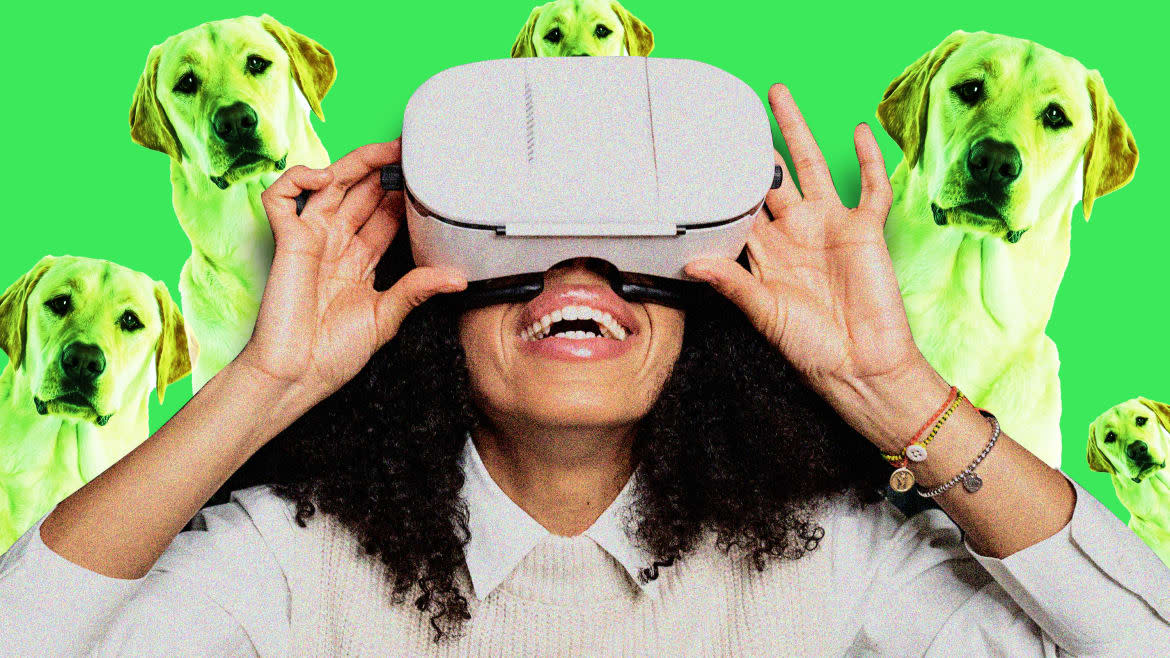A VR Labrador Can Help You Get Over Your Fear of Dogs

Picture in your head what a friendly dog looks like—head up, tail wagging, or rolling over and showing their belly might all come to mind. Now picture an aggressive dog—you might think of snarling, biting, or growling. It might seem like it should be easy to distinguish a friendly dog from a mean one, but we’re actually not that good at judging some of the early signs of dog aggression, as evidenced by the more than 300,000 emergency room visits every year for bites. These traumatic experiences can lead to the development of cynophobia, or the fear of dogs.
But scientists can’t just put people in rooms with aggressive dogs to see how they interpret the animals’ body language or help them overcome a phobia. Researchers in the U.K. created the next best thing: a virtual reality model of aggressive and nonaggressive dog interactions that they’re calling DAVE, short for Dog-Assisted Virtual Environment. They published preliminary findings of users’ experience in their dog VR on Wednesday in the journal PLoS ONE.
James Oxley, a co-author of the study and an animal researcher at the University of Liverpool, told The Daily Beast in an email that current virtual reality dog models often fail to depict true-to-life behaviors. Rather than exhibit behaviors of varying intensity (pulling the ears back before growling, for example), basic models only showed dogs performing tasks like walking, sitting, barking, and jumping.

The main menu of the DAVE application.
Oxley and his colleagues created DAVE to follow the canine ladder of aggression, a set of behaviors of increasing intensity that ultimately can lead to a bite. They rendered Labradors whose size and color could be customized (so yes, you could create Clifford the Big Red Dog in their model). Though it could lead to some weird looks for canines, the researchers chose a high level of customization because phobia treatments often have to be catered to an individual’s specific experience.
“The great thing about virtual reality is it can be highly controlled. If an individual has a phobia of a dog it can be slowly introduced and adapted based on the individual, including what particular dog behaviors frighten the person,” Oxley said. “It can even be started as an unrealistic size, color or behavior as a starting point. This may help to reduce any negative experiences of the VR dog.”
As a preliminary test, the researchers recruited 16 students from the University of Liverpool to try out DAVE and spend time in environments with a non-aggressive and aggressive virtual dog. For five minutes each, they were instructed to explore a living room in VR with a dog in one of the corners. On average, the participants ventured closer to the non-aggressive dog than the aggressive one; three people were “bitten” by the aggressive dog, which they felt as a vibration in their handset. Afterward, participants described what they noticed about each dog’s behavior to the researchers—the non-aggressive dog was described as “looking around” “relaxed,” “calm,” or “happy,” and “moving from standing to sitting”; the aggressive dog, on the other hand, was described as “moving back,” “nervous,” “scared,” or “unsure,” and “growling.”

A smattering of dog behaviors simulated by the DAVE program. The top row are non-reactive and non-aggressive behaviors, while the bottom row are aggressive behaviors.
To Oxley, this means that the virtual environment imparted the takeaways it was meant to.
“Participants were highly immersed in the environment and used the equipment with ease,” he said. “When interacting with both the non-reactive and aggressive dog models, participants frequently talked to the dog and attempted to stroke the non-reactive model. Some also got ‘bitten’ by the dog and reacted with surprise.”
At this stage, Oxley and his team are still researching how people react to the lower rungs of the ladder of aggression, in order to more sharply detect signs of reactivity and prevent dog bites. With further testing, the model could be used to lessen people’s fear of dogs, and even make them see Fido in a new light.
Get the Daily Beast's biggest scoops and scandals delivered right to your inbox. Sign up now.
Stay informed and gain unlimited access to the Daily Beast's unmatched reporting. Subscribe now.

